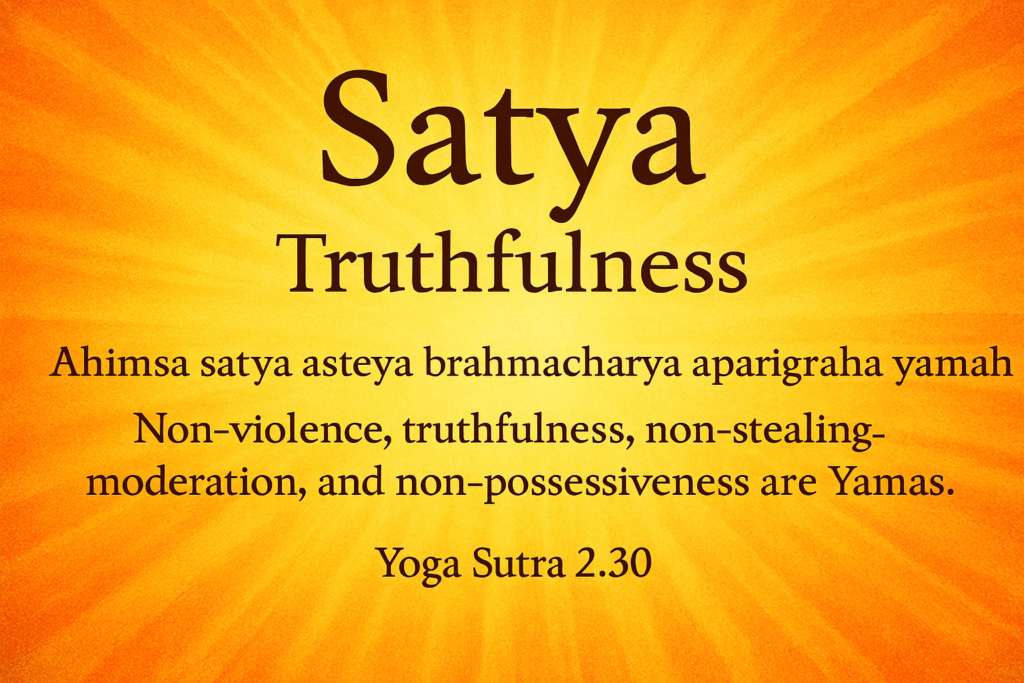Satya | The Radiance of Truthfulness in Yogic Living
In the tapestry of yogic philosophy, few threads shine as brightly—and as challengingly—as Satya, the principle of truthfulness. Rooted in Patanjali’s Yoga Sutras and woven into the Eight Limbs of Yoga, Satya is far more than honesty in speech. It is a call to radical authenticity, a practice of integrity that permeates thought, word, and action.
Satya in Patanjali’s Yoga Sutras
Patanjali introduces Satya as the second of the five Yamas—ethical restraints that form the foundation of the Eightfold Path (Ashtanga Yoga). In Yoga Sutra 2.30, he lists:
Ahimsa satya asteya brahmacharya aparigraha yamah
Non-violence, truthfulness, non-stealing, moderation, and non-possessiveness are the Yamas.
Satya is not merely about telling the truth. It’s about living in alignment with truth—your inner truth, universal truth, and the truth of the present moment. Patanjali deepens this in Sutra 2.36:
Satya pratisthayam kriya phala ashrayatvam
“When established in truthfulness, actions result in accordance with their intent.”
This sutra suggests that when one is firmly rooted in Satya, their words and actions carry power. They manifest clearly and without distortion. Truth becomes a force of clarity and effectiveness.
Satya Within the Eight Limbs of Yoga
The Eight Limbs of Yoga offer a progressive path toward spiritual liberation. Satya, as a Yama, is the first step in cultivating ethical discipline. But its influence ripples through every limb:
- Niyama (Personal Observances): Practicing Satya supports Svadhyaya (self-study) and Tapas (discipline). When we’re truthful with ourselves, we can see our habits clearly and transform them.
- Asana (Physical Postures): Satya invites us to move with honesty. Are we pushing beyond our edge to perform, or honoring our body’s truth today?
- Pranayama (Breath Control): Breath reveals truth. It reflects our emotional state, our energy, our presence. Practicing breathwork with Satya means listening deeply.
- Pratyahara (Withdrawal of Senses): Truthfulness here means recognizing when sensory input clouds our inner clarity.
- Dharana, Dhyana, Samadhi (Concentration, Meditation, Absorption): These meditative limbs require radical honesty. We must see what arises without judgment or denial.
Satya in Daily Practice
Living Satya is not always easy. Truth can be uncomfortable. It may challenge relationships, identities, and long-held beliefs. But when practiced with Ahimsa (non-violence), Satya becomes a compassionate mirror.
Here’s how Satya might show up in your day:
- Saying “no” when your body needs rest, even if others expect more.
- Admitting when you’re wrong, without defensiveness.
- Teaching from a place of lived experience, not borrowed wisdom.
- Holding space for others to speak their truth, even when it differs from yours.
Satya as Liberation
Ultimately, Satya is not a moral rule—it’s a liberation practice. When we shed the masks of performance, perfection, and pretense, we return to our essence. We become trustworthy, not just to others, but to ourselves.
In a world of curated images and filtered realities, Satya is revolutionary. It asks: What is real? What is true? What is mine to live?
And in that inquiry, yoga lives.
Continue your growth with the Vallarta Breeze Yoga Puerto Vallarta Yoga Studio!
Whether you’re looking to dive deeper into the physical practice of yoga, The Vedas, Upanishads, Yoga Sutras, or would like to explore our blog, we have a wealth of information available for you! Better yet, join us here in the Vallarta Breeze Yoga Puerto Vallarta Yoga studio, or practice with us online! we’re excited to continue this journey with you. See you on the mat!



